There’s something truly magical about walking into a kitchen filled with the aroma of warm, exotic spices. The fragrant blend of paprika, cumin, and cinnamon, combined with tender beef and sweet dried fruits, creates a symphony of flavors that transports you straight to the vibrant streets of Morocco. This Beef Tagine recipe captures the essence of traditional Moroccan cooking while remaining accessible to home cooks everywhere.
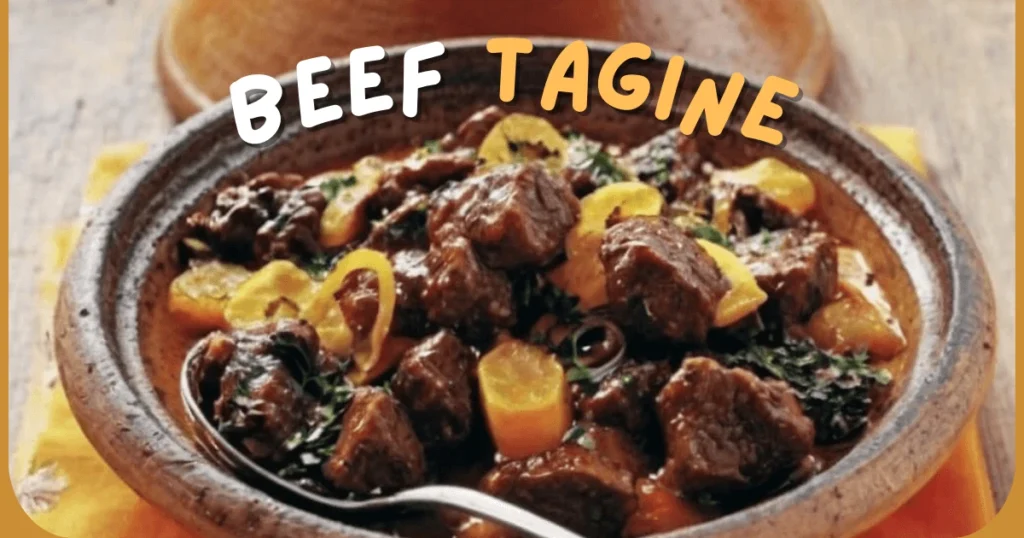
Table of Contents
The Magic of Moroccan Beef Tagine
This isn’t just another beef stew – it’s a celebration of flavors that has been perfected over centuries in North African kitchens. What makes this dish truly special is how the tender, melt-in-your-mouth beef mingles with a sauce that’s rich with complex spices and naturally sweetened with dried fruits. After experiencing countless stews from different cultures, there’s something uniquely comforting about a properly prepared tagine that sets it apart from all others.
The Cultural Significance
In Moroccan culture, tagine represents more than just a meal – it’s a symbol of hospitality and community. Traditionally served as a centerpiece during family gatherings and celebrations, this dish embodies the warmth and generosity that characterizes Moroccan hospitality. The slow cooking process allows families to gather, share stories, and create memories while anticipating the delicious meal to come.
The Perfect Balance of Flavors
What sets Moroccan tagine apart is its perfect balance of sweet, savory, and aromatic elements. The combination of tender meat, vibrant vegetables, and dried fruits creates a harmonious blend that excites the palate while remaining comforting and satisfying. Each bite offers a new discovery of flavors, making it an adventure for your taste buds.
Regional Variations
While this recipe presents a classic version of Beef Tagine, it’s worth noting that variations exist throughout Morocco. Coastal regions might incorporate preserved lemons, while mountain areas might add extra warming spices. Some versions include dates instead of apricots, while others might feature prunes or figs.
Understanding the Tagine Pot
The word “tagine” refers to both the distinctive cooking vessel and the succulent stew it creates. Traditional tagines are cone-shaped earthenware pots that have been a cornerstone of Moroccan and Algerian cooking for generations.
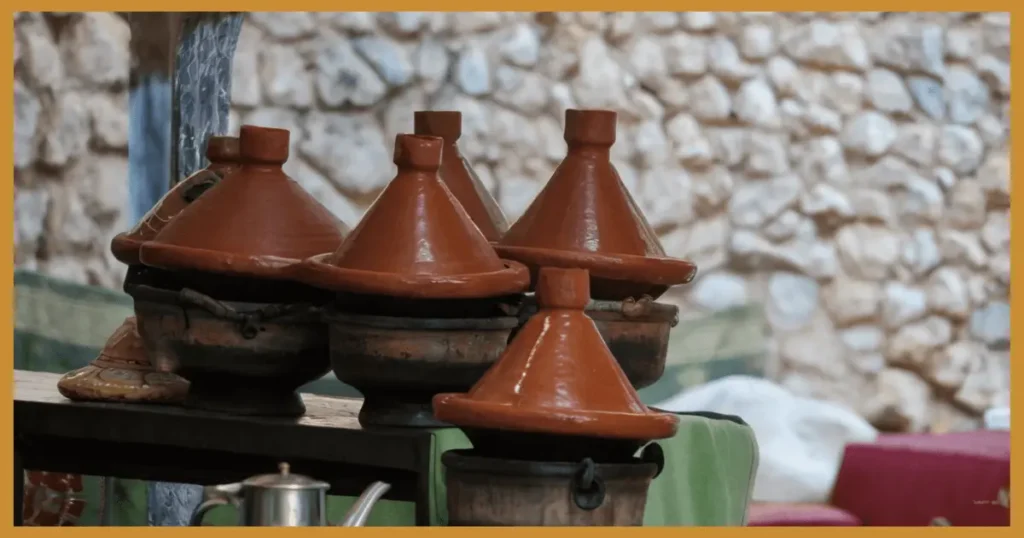
The Science Behind the Design
The genius of the tagine’s design lies in its tall, cone-shaped lid, which captures steam and continuously redistributes moisture back into the dish. This creates an efficient self-basting environment that results in incredibly tender meat and vegetables. The conical shape promotes condensation and returns moisture to the base, ensuring that the cooking ingredients never dry out.
Materials and Modern Adaptations
Traditional tagines come in various materials:
- Unglazed earthenware: Perfect for slow cooking but requires careful seasoning
- Glazed ceramic: More durable and easier to maintain
- Modern metal versions: Ideal for contemporary stovetops
- Decorative tagines: Beautiful for serving but not always suitable for cooking
Cooking Without a Tagine
While traditional tagines are beautiful and functional, don’t let the lack of one stop you from making this dish. A heavy-bottomed Dutch oven or large, deep skillet with a tight-fitting lid will work perfectly. The key is maintaining a moist, slow-cooking environment that allows the flavors to develop and the meat to become tender.
Essential Ingredients for Perfect Tagine
The Meat Selection
The success of your tagine largely depends on your choice of beef. Chuck roast is the ideal cut for this dish, and here’s why:
- Excellent marbling throughout the meat
- Becomes fork-tender when braised slowly
- Rich, beefy flavor that stands up to the spices
- Cost-effective compared to premium cuts
- Maintains its structure during long cooking
When selecting chuck roast, look for:
- Bright red color
- Good marbling but not excessive fat
- Firm to the touch
- Even thickness throughout
- Fresh-looking surface
The Spice Blend (Ras el Hanout)
The heart of any tagine lies in its spice blend. Here’s what you’ll need:
- 2 tablespoons Spanish paprika (provides deep, sweet flavor)
- 2 teaspoons ground cumin (adds earthiness)
- 2 teaspoons ground coriander (brings citrusy notes)
- 1 teaspoon ground cinnamon (adds warmth)
- 1 teaspoon ground turmeric (provides color and earthiness)
- 1 teaspoon ground ginger (adds warmth and spice)
- 1 teaspoon black pepper (brings heat)
- 2 teaspoons salt (enhances all flavors)
Fresh Ingredients
Aromatics and Vegetables:
- 2 large onions, finely chopped
- 6 cloves garlic, minced
- 2 tablespoons fresh ginger, grated
- 4 medium carrots, cut into 1-inch pieces
- 1.5 pounds baby potatoes, halved
- 2 cans (14.5 oz each) diced tomatoes
- 2 tablespoons tomato paste
Additional Components:
- 2 cans (15 oz each) garbanzo beans, drained and rinsed
- 1 cup dried apricots, halved
- 1/2 cup golden raisins
- 1/2 cup sliced almonds for garnish
- Fresh cilantro for garnish
Liquids and Oils
- 3 cups beef broth (preferably low-sodium)
- 1/4 cup olive oil for searing
- Additional water as needed during cooking
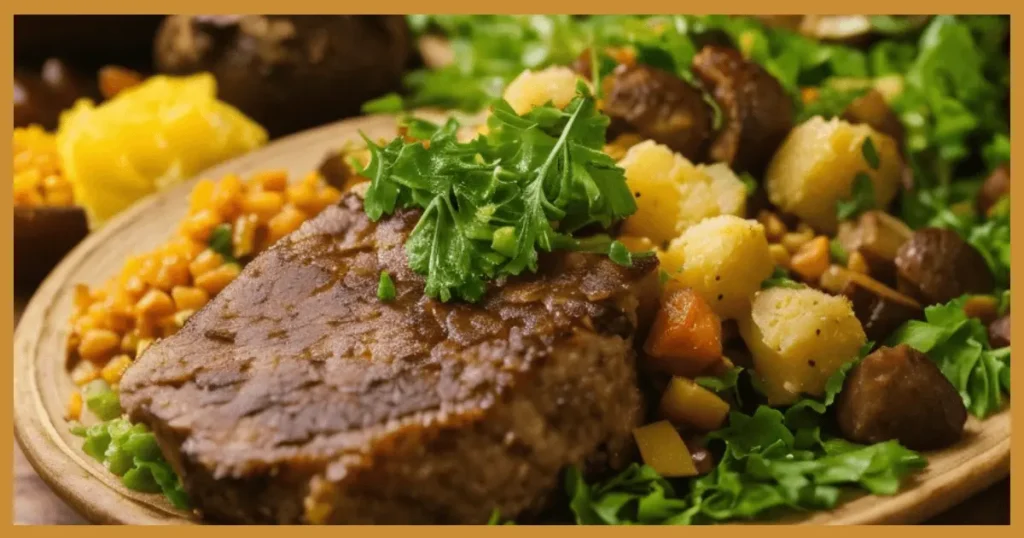
Detailed Preparation Method
Initial Preparation (30 minutes)
- Prepare the Meat:
- Cut 3 pounds of chuck roast into 1.5-inch cubes
- Remove any excess fat or sinew
- Pat the meat dry with paper towels
- Allow meat to come to room temperature (about 30 minutes)
- Create the Spice Blend:
- Combine all spices in a bowl
- Mix thoroughly to ensure even distribution
- Reserve 1 tablespoon for the sauce
- Prepare the Vegetables:
- Chop onions finely
- Mince garlic
- Grate fresh ginger
- Cut carrots into 1-inch pieces
- Halve baby potatoes
- Halve dried apricots
Cooking Process (3.5-4 hours)
- Searing the Meat (30 minutes):
- Coat beef chunks thoroughly with spice mixture
- Heat olive oil in Dutch oven over medium-high heat
- Work in batches (3-4) to avoid overcrowding
- Sear each batch for 8-10 minutes until well-browned
- Remove and set aside
- Building the Base (20 minutes):
- In the same pot, add onions
- Cook until soft and translucent (5-7 minutes)
- Add garlic and ginger
- Cook for 2 minutes until fragrant
- Add tomato paste and reserved spices
- Cook for 3 minutes to remove raw taste
- The Slow Cook (2.5-3 hours):
- Return meat to pot
- Add diced tomatoes and beef broth
- Bring to boil, then reduce to simmer
- Cover and cook for 45 minutes
- Add carrots and garbanzo beans
- Continue cooking for 30 minutes
- Add apricots and raisins
- Cook for another 1.5 hours
- Add potatoes in final 30 minutes
Final Touches and Serving
- Adjusting the Sauce:
- Check consistency (should coat back of spoon)
- Add water if too thick
- Simmer uncovered to reduce if too thin
- Taste and adjust seasoning
- Garnishing:
- Toast almonds in dry pan until golden
- Chop fresh cilantro
- Sprinkle both over finished dish
- Serving Suggestions:
- Over couscous (traditional)
- With fluffy rice
- Alongside crusty bread
- Over mashed potatoes
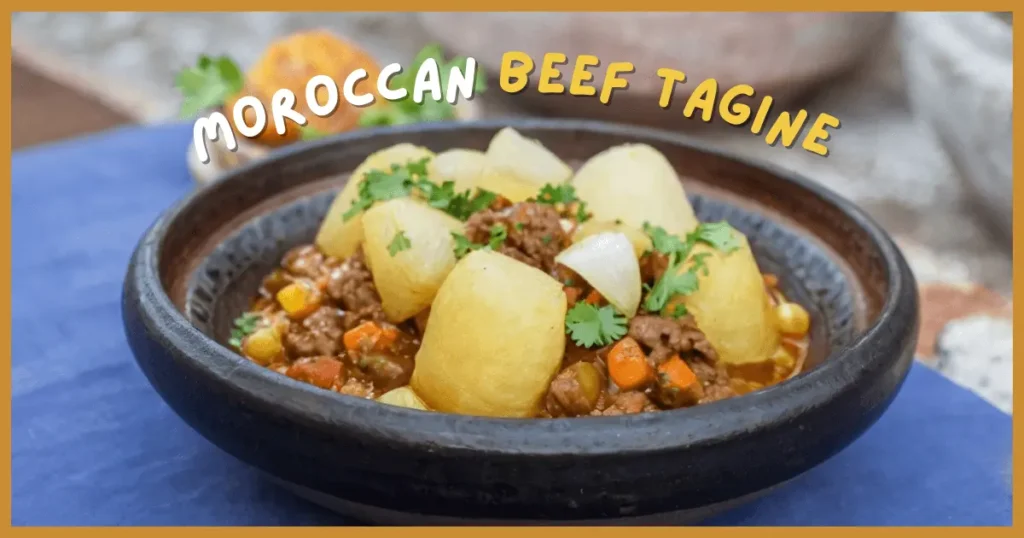
Tips for Success and Variations
Common Pitfalls to Avoid
- Temperature Management:
- Don’t rush the searing process
- Maintain gentle simmer during slow cooking
- Avoid boiling after initial stage
- Ingredient Handling:
- Don’t crowd the pan when browning meat
- Add vegetables at specified times to prevent overcooking
- Monitor liquid levels throughout cooking
Creative Variations
- Spice Adjustments:
- Increase cinnamon for sweeter profile
- Add cayenne for heat
- Include saffron for special occasions
- Fruit Alternatives:
- Substitute prunes for apricots
- Add dates for extra sweetness
- Include preserved lemon for authentic touch
- Vegetable Options:
- Add butternut squash
- Include sweet potatoes
- Incorporate bell peppers
Storage and Reheating
This tagine often tastes even better the next day, as the flavors have more time to develop. Here’s how to properly store and reheat:
- Refrigerator Storage:
- Cool completely before storing
- Keep in airtight container
- Consume within 4 days
- Reheat gently on stovetop
- Freezer Storage:
- Portion into freezer-safe containers
- Label with date and contents
- Freeze for up to 3 months
- Thaw completely in refrigerator before reheating
- Reheating Tips:
- Add small amount of water if needed
- Heat slowly over medium-low heat
- Stir occasionally to prevent sticking
- Check seasoning before serving
This Beef Tagine recipe represents the perfect marriage of traditional Moroccan cooking techniques with accessible ingredients and methods. Whether you’re cooking for a special occasion or simply want to explore the rich flavors of North African cuisine, this dish delivers a memorable dining experience that will transport you to the bustling souks and warm hospitality of Morocco.
Remember, the key to success with this recipe lies in patience and attention to detail. Don’t rush the cooking process – allow the flavors to develop slowly and fully. The result will be a deeply satisfying, aromatic dish that’s sure to become a favorite in your culinary repertoire.
The beauty of this tagine lies not just in its delicious taste, but in its ability to bring people together around the table. Serve it family-style, encouraging everyone to share in the communal experience that has made this dish a cornerstone of Moroccan dining culture for generations.
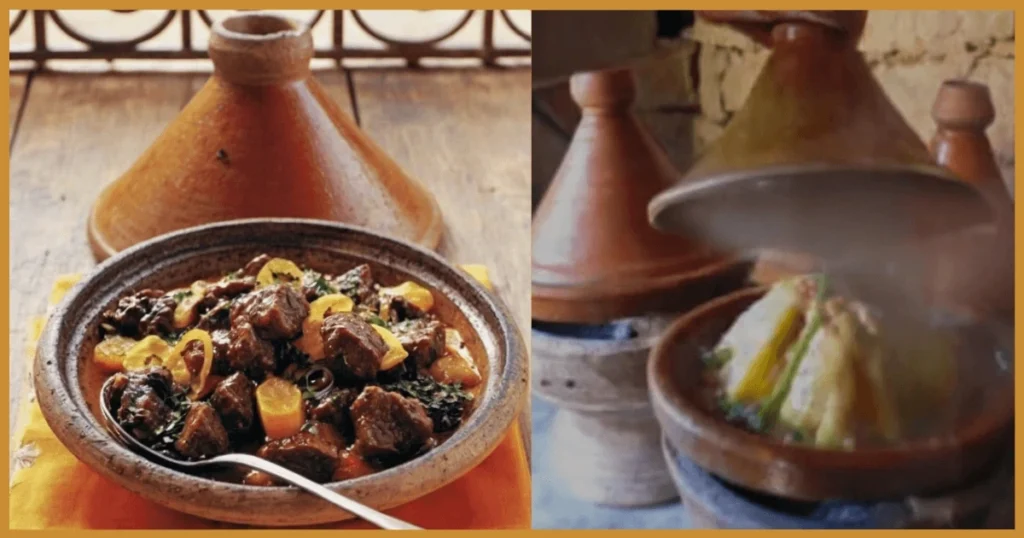
Frequently Asked Questions About Beef Tagine
General Questions
Q: Do I need a traditional tagine pot to make this recipe? A: No, you don’t need a traditional tagine pot. While these vessels are beautiful and authentic, a heavy-bottomed Dutch oven or deep skillet with a tight-fitting lid works perfectly well. The key is maintaining a moist, slow-cooking environment.
Q: How long does this recipe really take to make? A: The total time is about 4 hours, including:
- 30 minutes prep time
- 30 minutes for initial searing
- 2.5-3 hours slow cooking However, most of this is passive cooking time where you only need to check occasionally.
Q: Can I make this in a slow cooker or pressure cooker? A: Yes, you can adapt this recipe for both:
- Slow cooker: Cook on low for 8 hours or high for 4-5 hours
- Pressure cooker: Cook at high pressure for 45 minutes with natural release Just remember to still sear the meat and sauté the aromatics before transferring to either appliance.
Ingredient Questions
Q: What can I substitute for chuck roast? A: While chuck roast is ideal, you can also use:
- Beef brisket
- Beef shoulder
- Stewing beef Avoid lean cuts like sirloin as they won’t become as tender.
Q: Can I use regular paprika instead of Spanish paprika? A: Yes, regular paprika can be substituted. Spanish paprika (pimentón) adds a deeper, smokier flavor, but regular paprika will still work well. If available, try mixing sweet and smoked paprika for a similar effect.
Q: What if I don’t have all the spices listed? A: You can use a pre-made Ras el Hanout spice blend as a substitute for the individual spices. If missing just one or two spices, the dish will still be delicious – the key spices are paprika, cumin, and cinnamon.
Preparation Questions
Q: Can I prepare this dish in advance? A: Yes! In fact, the flavors often improve after a day or two. You can:
- Make it up to 3 days ahead and store in the refrigerator
- Freeze for up to 3 months
- Prep all vegetables and spices the day before cooking
Q: Why is my sauce too thin/thick? A: For thin sauce:
- Simmer uncovered for 15-20 minutes to reduce
- Mix 1 tablespoon cornstarch with cold water and stir in
For thick sauce:
- Add beef broth or water gradually until desired consistency
- Remember sauce will thicken as it cools
Q: How do I know when the meat is done? A: The meat is done when it’s fork-tender and easily pulls apart. This typically takes 2.5-3 hours of slow cooking. If it’s still tough, continue cooking and check every 20 minutes.
Serving and Storage
Q: What’s the best way to reheat leftover tagine? A: Reheat gently on the stovetop over medium-low heat, adding a splash of water or broth if needed. Stir occasionally to prevent sticking. Avoid microwave reheating as it can make the meat tough.
Q: Can I freeze individual portions? A: Yes, this dish freezes very well. Store in airtight containers for up to 3 months. Thaw completely in the refrigerator before reheating. The vegetables might be slightly softer after freezing, but the flavor will remain excellent.
Q: What side dishes work best with tagine? A: Traditional and complementary sides include:
- Couscous (most traditional)
- Steamed rice
- Crusty bread
- Roasted vegetables
- Moroccan salad
- Flatbreads like naan or pita
Dietary Considerations
Q: Can I make this gluten-free? A: This recipe is naturally gluten-free, just ensure your broth and spice blends are certified gluten-free if you’re highly sensitive.
Q: How can I reduce the sodium content? A: Use low-sodium beef broth and reduce added salt. You can always add more salt at the end if needed.
Q: Can I make this recipe with lamb instead of beef? A: Yes, lamb is actually very traditional in Moroccan tagines. Use lamb shoulder cut into similar-sized pieces and follow the same cooking method. The cooking time might be slightly shorter.
Remember, cooking is an art as much as a science. Don’t be afraid to adjust seasonings and cooking times to suit your taste and equipment. The key is patience and attention to how the dish develops during cooking.

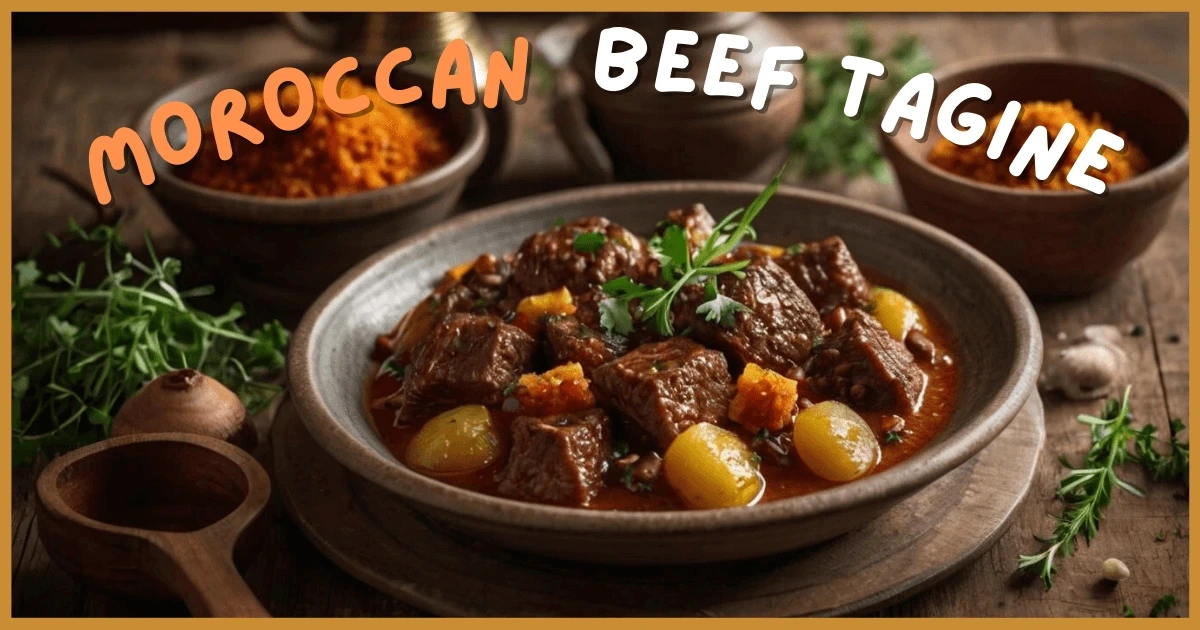

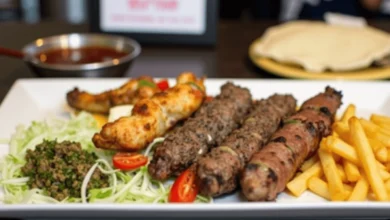
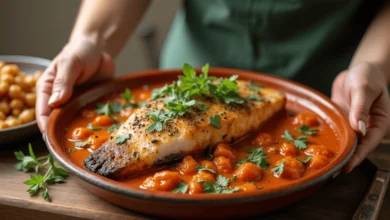


2 Comments